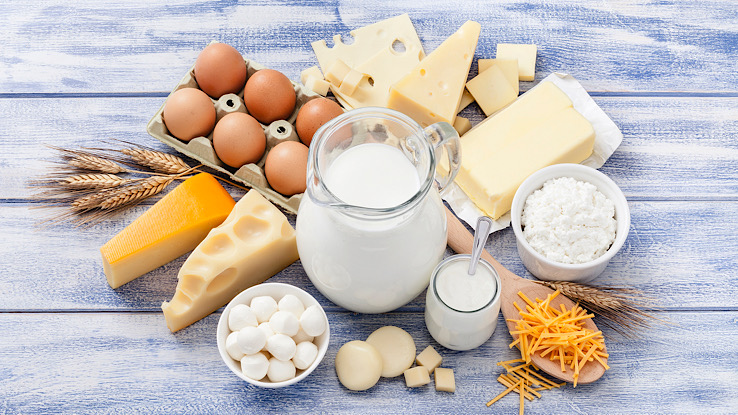
Many people are lactose intolerant. When you’re lactose intolerant, you can’t have dairy products because they have lactose — the sugar found in dairy products. Depending on how bad it is for you, symptoms can include nausea, gas, bloating, abdominal pain, and diarrhea. Although these symptoms can be painful, you can manage them by limiting dairy in your diet or taking supplements that help you break down the lactose you eat and drink. Read on to learn the signs you are lactose intolerant and how to control them.
Who Is Lactose Intolerant?
Dairy products are an important part of good nutrition, giving you calcium, vitamin D, protein, and other nutrients to your diet. Generally, all milk products from animals contain 5-7% lactose.
Your small intestine uses the enzyme lactase to digest this sugar. But, not all people have the ability to digest lactose completely. Also, lactose intolerance isn’t the same as an allergy to milk, which involves your body’s immune response to milk protein.
In the US, some populations — Native American, Black or African American, Hispanic or LatinX, and those from Asian and Middle Eastern backgrounds — tend to have lower lactase levels than the White American population.
About 4 in every 10 Americans have some level of lactose intolerance. Worldwide, about 6 in every 10 have this issue. In some rare cases, babies are born with no ability to make lactase, such as d premature babies. But the condition is usually short-term. Some people show lactose intolerance in early childhood, while for others, it gets worse as they get older.
Lactose intolerance sometimes happens when you have surgery on your small intestine or if it’s injured or infected. This may be temporary, and you could get better after your small intestines heal.
Signs You Are Lactose Intolerant
Signs and symptoms of lactose intolerance usually happen between 30 minutes and 2 hours after eating or drinking dairy products.
Here are signs you are lactose intolerant:
- Bloating
- Belly pain/cramping
- Nausea
- Diarrhea
- Gas
You don’t have problems if you stay away from dairy products because:
- Not all dairy products give you symptoms
- Your symptoms vary depending on how much dairy you eat
- Your symptoms are milder if you eat dairy with other foods
Plus, the severity of your symptoms will depend on how much lactase your body makes and how much dairy-containing food you eat.
Are There Tests for Lactose Intolerance?
Lactose intolerance has similar symptoms to other health conditions like irritable bowel syndrome, Crohn’s disease, ulcerative colitis, and celiac disease. If you experience symptoms, you’ll want to see your doctor and determine if lactose intolerance is the cause.
Your doctors will do a physical exam and ask you questions about your medical and family history, focusing on your diet. They’ll ask if family members have the same symptoms. They’ll also ask what makes symptoms milder, like eating smaller amounts of dairy foods or avoiding them altogether. Your doctor might tell you to stop eating dairy products for 2 weeks to see if symptoms disappear. Your doctor may suggest you try experimenting with your diet to see what level of lactose you can tolerate. This diet involves not eating dairy foods for two weeks, then gradually trying different types and amounts of dairy foods.
There are several tests your doctor can do to confirm if you have lactose intolerance, including:
- A challenge test: Your doctors will ask you to fast for 8 hours. Then they will give you a high-lactose drink and measure sugar levels in your blood. If your sugar levels don’t rise, lactose intolerance may be the cause.
- The hydrogen test: After fasting, you’ll drink a high-lactose liquid. Then the doctor will measure hydrogen levels in your breath. High levels are a sign of lactose intolerance.
- Stool acidity test: To check babies and small children, your doctor might do a stool test. High acid levels are a sign of lactose intolerance.
What Products Have Lactose?

There is no way to cure lactose intolerance, but there are several ways you can manage it. People vary in their level of intolerance. To identify foods that might bother you, you can look for lactose-containing ingredients on product labels. In addition to the words milk, cheese, and butter, look for:
- Whey
- Lactose
- Curds
- Milk by-products or “may contain milk”
- Nonfat dry milk or dry milk powder
Foods that contain small amounts of lactose are:
- Bread and other baked goods
- Milk chocolate and some other candies
- Salad dressings and sauces
- Breakfast cereals and bars
- Instant soups, potatoes, and rice or noodle mixes
- Some lunch meats
- Cheese-flavored crackers and snacks
- Mixes for pancakes, biscuits, and cookies
- Margarine and butter
- Organ meats like liver
- Sugar beets, peas, and lima beans
- Coffee creamers
Some prescription pills, such as birth control pills, have lactose in them. Some over-the-counter medicines like tablets for stomach acid and gas also contain lactose. These medicines usually only affect people who have severe intolerance.
Low-lactose dairy products like hard cheeses and yogurt may work for you. You may find you can eat dairy when you combine it with other foods. You can also try milk and cheeses with added lactase, which digests the lactose for you. Or you can use over-the-counter lactase drops or pills, which you can take before meals.
What Are Some Lactose-Free Products?
You don’t have to get your calcium from dairy products. You can add calcium to your diet with supplements or non-dairy foods that are rich in calcium like:
- Spinach
- Sardines
- Broccoli
- Calcium-fortified orange juice
- Fortified soy or almond milk
- Dried beans
- Tofu
Resource Links
- “Lactose Intolerance” via Johns Hopkins Medicine
- “Lactose Intolerance” via Cleveland Clinic
- “Milk Lactose from A to Zebra” via International Milk Genomica Consortium





